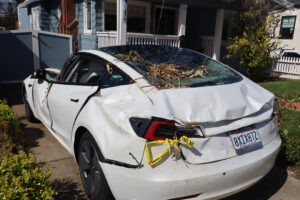
Most EV brands within hundreds of ICE vehicle cost to repair, Mitchell’s Q3 analysis shows
By onCollision Repair
A Mitchell International Q3 analysis indicates that non-Tesla electric vehicles (EVs) have neared cost parity with internal combustion engine (ICE) vehicles.
However, its claims performance director has cautioned that the latest figures offer just a snapshot of a vehicle subset and that the data could change over time.
Although Mitchell has yet to release its “Q3 Plugged in: EV Collision Highlights” report, Ryan Mandell, Mitchell’s claim performance director, told Repairer Driven News that it indicates repairs for non-Tesla EVs are $269 higher than the industry average.
“Certainly, the initial data from the quarter shows that the delta is not as great as what we’ve seen in the past,” Mandell said. “But we have to be very careful not to throw the baby out with the bathwater because we have to remember we’re talking about a subset of a subset of claims. So we’re talking about 25% of the EV claims, essentially, that are in the non-Tesla mix.”
He added that the data was pulled shortly after Q3 ended and that the data will typically mature for the next three to six months and will change as supplements come in.
“When you’re talking about a smaller data set, it’s more prone to rapid change with those supplements,” Mandell said. “It’s also more prone to variability.”
When asked why EVs remain more expensive to repair than ICE vehicles, he said they typically require more labor hours and have a higher utilization of OEM parts.
In the case of Tesla, repairs are $1,347 more expensive than other vehicles. Mandell said there are a number of reasons for that discrepancy, including fewer sectioning opportunities.
“This is not a knock against Tesla by any means but I think their vehicles are designed in such a way that they’re made to absorb crash energy very efficiently and to protect the passengers in the compartment,” he said. “That involves the use of things like gigacast parts, where large assembly parts are being passed as one piece as opposed to several pieces being welded together. That has the potential to increase the strength of that part but it also reduces repairability, so the likelihood of being able to actually fix one of these structural parts, as opposed to having to replace the entire thing, is reduced.”
The latest figures are lower than they were in Mitchell’s Q2 Plugged In report, which found severity costs were higher for EVs by $963 in the U.S. and $1,328 in Canada. For Tesla specifically, costs were $1,589 and $1,600 higher respectively, Mitchell said.
That report also noted that EVs continue to take more time to repair with an average of 8.51 refinish hours, compared to 8.02 refinish hours for ICE vehicles.
Mitchell’s survey found OEM parts utilization to be higher among EVs as well, with 90.75% using original parts versus 66.5% for ICE vehicles. EV repairs required a lower percentage of parts as well.
Updated data on cycle time and OEM parts utilization was not yet available for Q3.
Mandell said Michell could produce a more comprehensive report on EV repair costs next year after all of this year’s data has matured.
“We can take a look back at 2023 and make some good conclusions,” he said. “When we’re looking at a full year’s worth of data, that’s going to be a lot higher fidelity when we’re talking about being able to make some conclusions based on that.”
Images
Featured image courtesy of Arun1/iStock
